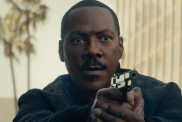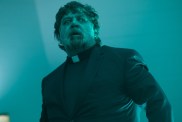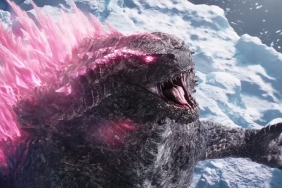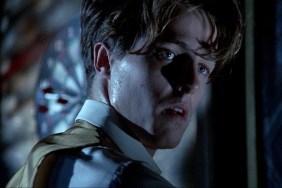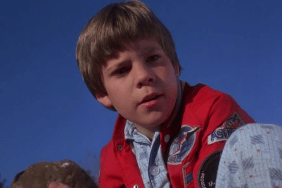
Back in August of 2011 Criterion hinted they would be adding the classic Japanese monster movie Godzilla (Gojira) to their collection. This immediately sparked online enthusiasm and was shortly thereafter confirmed for release. And not only would we be receiving a new high-definition digital restoration of the 1954 original, but an HD restoration of Terry Morse’s 1956 Godzilla, King of the Monsters along with a commentary on both films and a disc full of interviews and featurettes.
For me, however, the biggest realization at that time was… I had never seen Godzilla, a fact I remedied only days later.
In what served as good preparation for this release, last August I watched both Ishiro Honda’s 1954 original as well as Morse’s remake from a couple of years later for the first time, the latter of which uses footage from Honda’s film and recuts it around a new story featuring Raymond Burr as American journalist Steve Martin who, on his way to Cairo, stops off in Tokyo only to find himself involved in the goings on from the original film. Morse not only included footage from Honda’s feature but the same actors return to allow for this new character to become part of the story. What’s most interesting about the release is that in cutting about 40 minutes of the original film there becomes a noticeable absence of references to Nagasaki and other H-bomb references that might not have been approved of by American audiences.
Personally, Godzilla, King of the Monsters is only of a passing interest to me that I’m unlikely to return to again, but the fact Criterion chose to include it here as a “supplemental feature” is just as much a treat as it was when they included Killer’s Kiss on their presentation of Stanley Kubrick’s The Killing. It’s this kind of thing that makes Criterion titles worth the additional money and this Godzilla package is one such instance.
Both films look excellent, outside of some scratches on the Godzilla transfer that are likely unavoidable due to the source material and the lack of funds to do a full restoration, but I’d argue in this case that only adds to the effect. Each film is presented with an uncompressed monaural soundtrack and both come with an audio commentary from film historian David Kalat who wrote “A Critical History and Filmography of Toho’s Godzilla Series“. Kalat’s commentary is passionate and informative and helps expand on how the film come into being amidst the fallout after the dropping of the atomic bomb on Hiroshima and Nagasaki, an obvious theme that continues throughout the majority of the commentary and included interviews and featurettes.
When it comes to the interviews and featurettes, the highlight for me was the featurette detailing the photographic effects in the film and the numerous matte paintings and in-camera glass painting effects that were used. After two brief interviews with special effects director Koichi Kawakita and special effects photographer Motoyoshi Tomioka, the featurette shows you the before and after images and it is utterly astonishing how convincing the effects are.
As for the interviews, which include conversations with Akira Takarada who plays Hideto Ogata in the film, special effects technicians Yoshio Irie and Eizo Kaimai, score composer Akira Ifukube and Japanese-film critic Tadao Sato, I found the nearly ten-minute discussion with the man who played Godzilla himself to be the most entertaining. Haruo Nakajima discusses how he went about creating the monster’s movements as he wore the suit made of latex and plastic, which he says weighed 220 pounds.
On top of trailers for both films, the release is rounded out by a feature titled “The Unluckiest Dragon,” which really ties in well with Kalat’s commentary and the rest of the disc for that matter as historian Greg Pflugfelder explores the fate of the Daigo Fukuryu Maru, a fishing vessel affected by fallout following a United States nuclear test on Bikini Atoll. This instance is more-or-less recreated at the beginning of Godzilla and is referenced throughout the special features. In fact, you may just want to watch this ten-minute feature before even watching the movie or any of the other special features as it should serve as a good starting point for exploring the entire release.
The interesting thing about Godzilla is that it can be looked at two ways; 1) as a monster movie or 2) as a metaphor and a historic piece of commentary on nuclear warfare. Then again, I guess it can also be looked at for the influence it has had on years of monster movies and its spectacular use of visual effects. Most importantly, when it comes to the Criterion Collection I don’t think there will be a doubt in your mind after exploring this release that Godzilla is most certainly a film that belongs among the collection’s vast number of iconic films.
And now, as one final preview, I really liked what I found once I opened up the packaging not to mention the cover art created by Bill Sienkiewicz, so I put together the following video to show you just what exactly Criterion put together.
In fact here’s a comment from Criterion regarding the cover art that was posted at Blu-ray.com following concerns from a few people that Sienkiewicz’s Godzilla just might look a little too much like Roland Emmerich’s Godzilla:
Artist Bill Sienkiewicz used the original, ’54 Godzilla as reference for his artwork, but all of the renderings are nevertheless, in the end, Bill’s personal vision of the creature, albeit on…e that is Toho approved. We can see why some viewers consider it to be more akin to the 2002 incarnation of Godzilla because the back plates seem more sharp-pointed and jagged than the curved tips of the ’54 original, for example, or the tail tapers more to a point, but those plates don’t exactly mirror the ones from the 2002-3 monster either.
We pushed Bill to address Godzilla as a force of destruction, an elemental being, to step away from a rendering that would be purely literal and fetishistic in detail, and think he came up with a terrific interpretation. This is also why there is color in the packaging art. Although the movie is a beautifully-photographed B&W work, we kept leaning towards the elemental aspects of fire and water and wanted the color palette to evoke that.
And that said, here’s what is offered on the inside:
